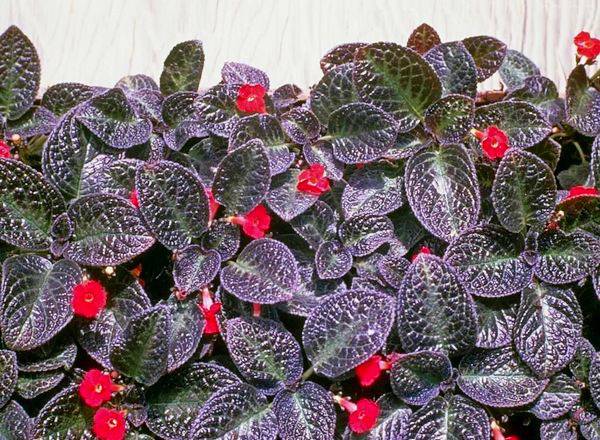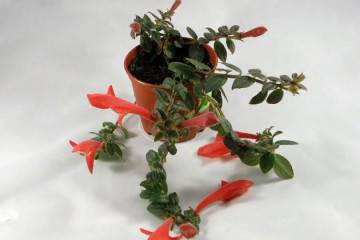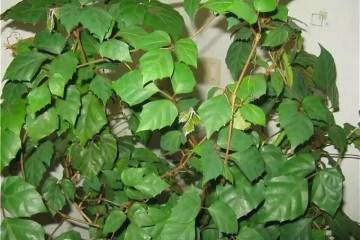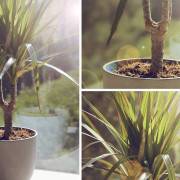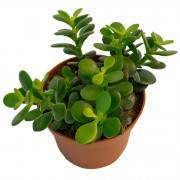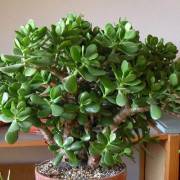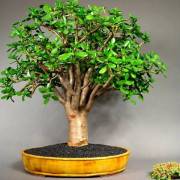Episation - home care and plant varieties
Content:
Episation is a flower that amazes with its appearance. Ampel culture is represented by many species and varieties. Care at home is required thorough. Novice growers should learn the basic growing rules and nuances.
Description of the flower episode
It belongs to the Gesneriev family. There are 30 species in the genus. Natural habitat - rainforests of Central America. There, in constant dense shade, the culture grows under the bushes. Its numerous shoots spread along the ground.
The decorative properties of the plant are given by patterned, slightly pubescent leaves. They are assembled into an outlet. In some varieties, they are smooth and shiny, in others they are textured velvety. The richness of colors is striking: emerald, brown and red, silver and copper, violet. There are light green and pearl.
Leaves are the backdrop for graceful phonographs of lilac, white, orange.
In everyday life, the plant is called a peacock flower, as well as a chameleon and an African violet.
Blooms from early spring to late autumn.
Episode: home care
Indoor flower episode is not capricious. Here are its basic requirements:
- lighting. Light is needed bright, but diffused. Under direct rays, the leaf plate loses its beautiful appearance. In low light, the stems become thinner, do not give side shoots. The flowering period is shortened;
- high humidity is needed. But the episode does not like spraying the leaves, as they rot. The pot is placed on a pallet with wet expanded clay. Pour over it or along the edge of the dish. Cold water and excessive moisture lead to disease;
- the temperature in summer requires 20-25 ° С, but can withstand up to 35 ° С. In winter, it should be at least 18 ° С;
- top dressing. Complex or organic fertilizers are used. In the summer, they bring in 2 times a month. Granules and powders are acceptable. Overkill leads to illness;
- pruning. A beautiful crown is formed by pruning overgrown shoots;
- priming. Light with medium acidity pH 5.5-6.5 is suitable. The substrate is prepared from 3 parts of leafy soil and 1 part of peat and sand. Sphagnum and ash are added to the soil mixture. Soil suitable for violets.
How to care for the episode in winter, suggests the experience of growing tropical crops. The plant is kept warm, maintains high air humidity, fertilizing is reduced to once a month, protected from drafts, and placed away from heating appliances.
Bloom
The culture blooms for a long time - from early spring to late autumn. The flowers are not large axillary in the form of gramophones. Their size is 2 × 3 cm. The buds are bright: white, yellow, purple, speckled. Each has 4 single tubular stamens. Delicate flowers are beautifully combined with lush foliage of different colors.
After flowering, a dormant period begins. Fertilizers and watering are reduced. When daylight is lacking, they are illuminated with lamps.
Pruning
One of the pleasant agronomic activities burdens the owners when it comes time to prune.Genetically, the culture is prone to disorderly growth by creeping processes. It looks like a propagation of strawberries. The flower produces leafless shoots - a mustache. Young plants are formed at their ends.
The bush soon becomes unkempt, so the daughter shoots are cut off. Sockets are immediately planted in a pot. Leave for a lush bush, or as planting material.
They form an aesthetically pleasing crown with a haircut. The procedure is carried out in the fall, winter or as needed.
Reproduction
Reproduction of episodes can be vegetative (cuttings, leaves) and seeds.
Seed propagation
To apply this method, they will learn how to collect seeds from the beauty of the episode. Seed pods rarely ripen. Cross-pollination is foreseen by nature. If self-pollination occurs at home, the seed pods will ripen.
Inside, in a jelly-like mass, there are small black seeds. They are disinfected, laid out in bowls on prepared soil. Press with a spoon, cover with a film, spray with care. Seedlings are planted.
The method is ineffective, painstaking. The result is that the plant loses its maternal properties.
Leaf propagation
A healthy leaf is separated from the bush, immersed in water by 1.5-2.0 cm. Callus (white shiny outgrowth) and root rudiments will soon form. The leaf is transferred to light nutrient soil. A mini-greenhouse is created above it from a bag with holes. After the time has passed, the old leaf dries up. They do not tear it off, they wait for it to fall off spontaneously, when the plant starts growing.
Propagation by cuttings and rosettes
Cut the cuttings with 4 knots. Water is poured into a dark dish, an activated carbon tablet is thrown. The stalk is immersed 4-5 cm. When the roots appear, the plant is transferred to a pot. As it grows, once a month, it is transplanted into a large container by the transshipment method.
The stalk can be placed directly into the ground. The shoot is covered with a jar, poured into a tray.
The method is technically easy. The result is full compliance with the mother bush.
Rosettes that form on leafless stems are good planting material. They are cut off, dripped in a pot with a bush. When the roots appear, they are transplanted into a new container. Varietal qualities are not affected at the same time.
Transfer
The young culture is transplanted once a month. Mature bushes - annually. The dishes are taken wide, but low. Sphagnum and charcoal are added to the soil. Drainage is placed at the bottom.
Before the procedure, the plant is moistened to make it easier to remove it with an earthy clod. If there are several young plants in the pot, separate. They add new soil and water it.
Possible growing difficulties
The main danger is root rot. This is when the ground is wet, and the plant for some reason looks sluggish. It was poured in at low temperature, low light, or in a pot with poor drainage.
When rot develops, you need to cut cuttings from a bush, root in water or soil, and plant a new plant. The old earth is thrown away, the pot is boiled.
When there is not enough moisture, the tips of the leaves dry out. If there is little light or too dark, they curl, lose color.
The plant is sometimes attacked by pests: aphids, mealybugs, root nematodes. They fight them with insecticides.
Types of episode
In home floriculture, an episode of several varieties is grown:
- Episode Northern Light (Northern Lights). Leaves are small, undisturbed, they have a mother-of-pearl tint. Flowers are dark red, solitary;
- Emerald Velvet. The leaf is dark olive with green veins, it is large, ovoid, pubescent. The flowers are light lilac with a white core;
- Episode of Silver Skies. A miniature variety of culture. Leaves are green with a raspberry tint, carmine flowers;
- Tiger Stripe Episode. Patterned marsh-colored leaves. They have a tiger pattern on them. The flowers are scarlet;
- Episode of Strawberry Mist. Embossed leaves of a dark pink color appear red from a distance. Pearlescent tint and green veins make the plant incredibly beautiful.The flowers are orange, red with a yellow center;
- an epic of Spring Symphony. A silvery stripe runs along the center of large leaves. Large textured sheet. The color is olive with a brown tint. The flowers are orange-red serrated at the edges. The neck of the flower is yellow;
- Episode Yellow Mist. The leaves are large, oval. The surface is smooth with a silvery sheen. Flowers are deep yellow, solitary;
- clove Episcia Dianthiflora. The leaf shape is eleptic. The edge is noticeable. Colors are all shades of green. The flowers are white, carnation-like;
- Forest beauty (Silvans Beauty). Glossy leaf plates with light green veins. The buds are red;
- Blue Nile. Large flowers with a lavender hue. At the core they are yellow;
- Harlequin. Blooms profusely, flowers are red. Leaves up to 10 cm silvery green with checkered;
- Country Clown. Red leaves with dark edging;
- Sea Foam. Small watercolor pink leaf. A powerful bush with many shoots. The flowers are red;
- Pink Metallic. Olive foliage with ruby dusting;
- Raspberry Blush. Large red-brown leaf. The flower is red;
- Silver shine (Silver Sheen). Large pubescent leaves with an olive border. The flowers are red and orange;
- Pink Panther. The leaves are lime green with a bronze tint. Flowers with a corrugated edge, pink;
- Country Kitten. Small chocolate-colored leaf plates. The flowers are red-orange;
- Brown Beauty. The leaves are textured, the tint is silver. The flowers are red;
- Brown Beauty. Velvet olive green leaves. Pink spotted flower;
- Episcia Jim Moody Rock. Quilted leaves with black diamonds;
- Lemon Lime. The leaf plate is green with a brown tint, in the middle there is an emerald strip. The flower is pink;
- Strawberry Patch. Pink foliage with a metallic sheen. Red-orange flower;
- Canadian Sunset. Velvety leaves are olive green. Spotted pink flowers;
- Episation Chocolate Velor. The foliage is heavily pubescent, dark brown, the flowers are lilac-blue;
- Episcia Temptation. Shiny leaves with jagged edges, red-orange flower;
- Episcia Lilacina Viridis. Large ovoid dark green leaves. Lavender flowers;
- Episode of TM-Lear. Shades from silvery to pink-red at the edges of the sheets.
Episation is a plant of exceptional beauty. Valued for the variety of leaf shapes and colors. Care has its own characteristics, but within the power of a novice florist. Propagated by cuttings to maintain genetic properties. Watering, transplanting, pruning - within the requirements of agricultural technology.




